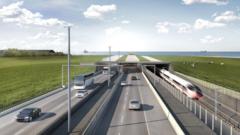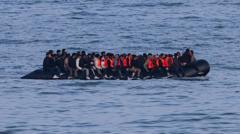Under construction in the Baltic Sea, the Fehmarnbelt is set to become the world's longest pre-fabricated road and rail tunnel. Scheduled for completion in 2029, it will significantly decrease travel times and cut carbon emissions, linking Denmark and Germany efficiently.
Groundbreaking Fehmarnbelt Tunnel Set to Revolutionize Travel Between Denmark and Germany

Groundbreaking Fehmarnbelt Tunnel Set to Revolutionize Travel Between Denmark and Germany
The Fehmarnbelt tunnel aims to enhance connections between Scandinavia and central Europe while promoting sustainability through reduced travel times.
A transformative construction project is underway as the Fehmarnbelt tunnel takes shape beneath the Baltic Sea, connecting Denmark and Germany. Spanning 18 kilometers (11 miles), it is poised to become the world's longest pre-fabricated road and rail tunnel, revolutionizing travel times in the region and strengthening links between Scandinavia and central Europe.
The creative engineering of the Fehmarnbelt includes assembling large segments known as "elements" on the seafloor, rather than conventional tunneling methods. The project's main construction site is located on Lolland Island, Denmark, encompassing 500 hectares (1,235 acres) dedicated to manufacturing these elements. "The scale of this facility is remarkable," notes Henrik Vincentsen, CEO of Femern, the state-owned enterprise overseeing the tunnel's construction.
These tunnel sections, measuring 217 meters (712 feet) long and 42 meters wide, will be meticulously crafted using reinforced steel and concrete. “We’re setting new benchmarks with this endeavor,” Vincentsen states, highlighting that while immersed tunnels exist, none have been constructed at this magnitude. Upon completion, the new passage will allow travelers to journey between Rødbyhavn in Denmark and Puttgarden in Germany in just 10 minutes by car or seven minutes by train, compared to the current 45-minute ferry ride. Moreover, the rail link will halve the travel time between Copenhagen and Hamburg, transforming freight and passenger transportation and minimizing flights.
"This project not only connects Denmark to Germany, but it also links Scandinavia to central Europe," asserts Vincentsen. The environmental aspects have not gone unnoticed, as fewer kilometers traveled will lead to reduced carbon emissions. The construction site, with its towering cranes and extensive infrastructure, represents a leap towards sustainable transport solutions.
As the tunnel progresses, construction manager Anders Gert Wede notes the intricate work of preparing and immersing the heavyweight elements into a pre-dug trench on the seabed with precision. Using advanced underwater cameras and GPS equipment, teams ensure the elements meet with remarkable accuracy.
The decision to go ahead with an immersed tunnel arose after careful consideration of safety and environmental factors, particularly regarding the area’s unique underwater ecology. Although some opposition emerged from conservation groups concerned about marine life, a court ruling in 2020 allowed the project to move forward. In response, the development team has committed to reducing ecological impacts, including plans for a wetland nature area constructed from dredged materials.
Set to open in 2029, the Fehmarnbelt tunnel is projected to accommodate over 100 trains and 12,000 vehicles daily. The funding model is predicated on toll collections, which are expected to repay state-backed loans over the next 40 years. Beyond its travel benefits, locals are hopeful that the new tunnel will foster economic growth, job creation, and increased tourism in one of Denmark’s less prosperous areas. "The community has eagerly anticipated this project for many years," Wede says, emphasizing the positive outlook among residents.





















